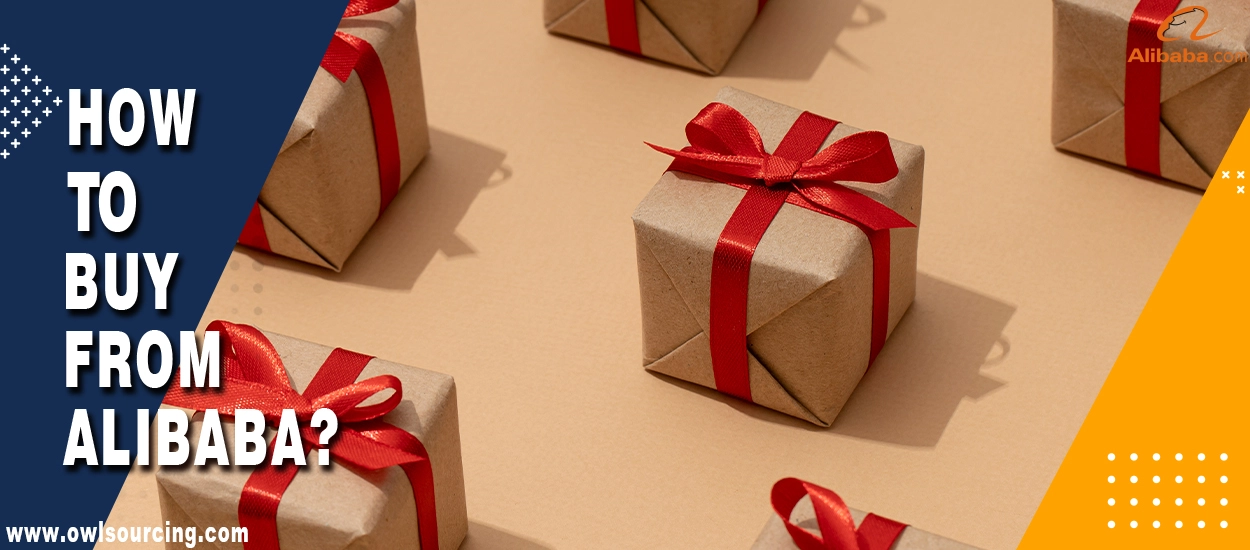As e-commerce is growing at high speed, more and more online sellers or retail stores will need to seek suppliers through Chinese wholesale websites such as Alibaba.
If you’re using a guide on how to search for the right product and identify the top China suppliers on Alibaba, then please continue reading this post.
In this post, we will detail how to source and purchase the right product on Alibaba!
Alibaba
How to buy wholesale from China? Maybe “Alibaba” is the answer for some people who are online sourcing from those wholesale sites.
Alibaba is one of the biggest and most famous e-commerce companies that unite millions of buyers and sellers, and millions of goods.
When planning an online business from the ground up or expanding, you will probably look into buying from Alibaba due to the company’s 779 million active consumers by the end of 2020.
As of 2023, Alibaba had over 1.28 billion active users globally, with the majority of them coming from China.
reference: Techreport
The Rise of Alibaba
The brainchild of Jack Ma, it was established in 1999 with the basic concept of acting as an electronic trading platform for small enterprises. It evolved over time into an international online business company.
Some of the main events in Yahoo’s roller-coaster journey involve the firm’s major investment of $1 billion in 2005 and the billion-dollar IPO record of $ 25 billion in 2014.
Today, it has evolved into a much more complex company; it is not only an e-commerce company but also involved in cloud computing, entertainment, etc.
Alibaba’s Main Platforms
- Alibaba.com: A vertical market B2B platform that assembles buyers from one industry and manufacturers from another.
- Taobao: A B2C platform that is to be targeted for small retail businesses.
- Tmall: A B2C platform that sells luxury brands and large firms.
- AliExpress: An International platform, such as Taobao, delivering its products across the world.
How Alibaba Works
Alibaba basically acts as a middleman, linking sellers and consumers, mainly on the B2B platform.
Thus, it does not possess inventories or warehouses; however, it helps to identify suppliers, manage digital transactions with them, and deliver their products in case needed.
Purchasers are able to sift through products, bargain with sellers, place sample orders, and effect purchases over the internet.
Alibaba also provides verification services for suppliers, which makes everything clear.
Benefits of Purchasing on Alibaba
- Cost-effective: The website offers competitive wholesale prices.
- Extensive product range: Millions of product options.
- User-friendly platform: The work solves such problems of potential customers as they search for products and make their purchases.
- Verified suppliers: In the verification program, companies work to contact and vet suppliers.
- Quality control services: Additional services, including only receiving inspections and Trade Assurance by the buyer.
What is the difference between Alibaba and Aliexpress?

Alibaba.com
What is Alibaba? Alibaba is a Chinese wholesale website created by Jack Ma and his team in 1999. It has become the most extensive online B2B wholesale site for buyers who want to buy directly from China.
It offers users the opportunity to source various products from different Chinese wholesale suppliers. Generally speaking, Alibaba works like a broad dashboard with its wholesale directory function.
Check out our comprehensive article on the “Best Items to Flip on Alibaba“—a must-read for anyone looking to maximise profits!
Aliexpress.com
Founded in 2010, AliExpress (Alibaba Express) is the Alibaba Group’s new cross-border retail platform for the global market.
After nine years of rapid development, AliExpress has become China’s largest cross-border B2C export platform.
Aliexpress designed its service for customers who want to buy from China at competitive prices. It’s a Chinese online shopping site that works for international buyers.
Alibaba works for importers who want to private label their products and experience the OEM/ODM service from Chinese suppliers.
At the same time, Aliexpress targets customers who intend to get cheap Chinese products or purchase them in small quantities.
How to Buy from Alibaba?
| Step | Actions & Details |
|---|---|
| 1. Creating an Account | Sign up on Alibaba.com by clicking “Join Free,” entering your email, creating a password, and completing verification. Specify your trade role (buyer, seller, or both) for a tailored experience. Provide your company name, address, and contact details for credibility and smoother supplier communication. |
| 2. Finding Products | Use the search bar to enter product-related keywords (e.g., “custom t-shirts”). Browse categories like Electronics, Apparel, or Machinery to explore options. Apply filters such as “Verified Supplier,” “Gold Supplier,” or “Trade Assurance” to work with reputable sellers. |
| 3. Contacting Suppliers | Prioritise suppliers with “Verified Supplier” or “Gold Supplier” badges for reliability. Click the “Contact Supplier” button to inquire about pricing, MOQ, shipping, and payment terms. Use the RFQ (Request for Quotation) feature to get quotes from multiple suppliers for bulk orders. |
| 4. Negotiating with Suppliers | Always negotiate pricing, as suppliers expect it and often have flexibility. Request a lower MOQ if needed, especially as a first-time buyer. Order samples to verify product quality before placing a bulk order. Discuss payment methods like T/T (bank transfer), PayPal, or Alibaba’s Trade Assurance for secure transactions. |
| 5. Placing an Order | Choose the “Ready to Ship” option for in-stock items to expedite processing. Click “Start Order” and double-check all details, including quantity, price, and shipping terms, before confirming. Use secure payment options like Alipay or Trade Assurance to protect your transaction. |
| 6. Managing Shipping & Logistics | Consider using Alibaba Freight for streamlined logistics. Choose air freight for faster delivery or sea freight for larger, heavier shipments. Be aware of customs regulations and import duties in your country; hiring a customs broker can simplify the process. Confirm estimated delivery times with your supplier, as they vary by shipping method and destination. |
How to Shop from Alibaba Risk-Free
Shopping at Alibaba seems simple, until it isn’t. While the site gives you access to thousands of suppliers, it is difficult to tell who’s real, who’s a trading company, and who’s going to deliver the product you’ve vetted.
At Owlsourcing, we chop the uncertainty. We bring you screened, factory-direct suppliers, so you don’t waste your time sorting through unvetted listings or getting caught in costly traps.
✅ Screened Factories, Not Listings
We vet each supplier before your order. That’s real factories, real capacity, and no surprise middlemen.✅ End-to-End Sourcing Support
From supplier finding, sample inspection, and price discussion to production management, quality control, and overseas shipping, we handle it all.✅ Clear Pricing. No Surprises.
Our prices are clear and transparent, based only on your order size, specifications, and service needs. No inflated invoices. No last-minute changes. Just clean, honest buying.Why Alibaba Isn’t the Whole Story
It’s simple to find a nice-looking product photo or a friendly salesman on the web. But…
- Is the supposed manufacturer indeed the manufacturer?
- Will your mass production match your sample?
- What happens in a delay, defect, or substitution of materials?
These are traps for new and old buyers alike. Alibaba is just the platform. Real success occurs in the background.
Owlsourcing Is Your Advantage
Where other buyers gamble on Internet listings, our clients work with a team already entrenched in China’s supply chain. We’re here, on the ground, where it counts, speaking the language, reporting from the factories, and ensuring your products are what you approved.You can order blindly out of a chat window, or you can work with a sourcing team that protects your time, money, and reputation.
Let Owlsourcing handle your next buy from sourcing through delivery—with factory-verified suppliers and open pricing from day one.
👉 Contact us today to get started.
How do Chinese wholesalers rank on Alibaba?
Do you know about the ranking rules on Alibaba.com? If not, please carefully read the article.
Some customers asked me about how the Alibaba stores rank on the site.
The websites work as a search engine by which you can type the target keywords, and then it returns the matching results. It’s free to buyers, but it does charge a membership and promotion fee to the sellers.
What you may not know is that there are different types of membership fees for the suppliers to obtain different levels of traffic on Alibaba.
The suppliers who pay more to the website, then would acquire a high-ranking listing on the site. Does it sound similar to Google ads and Facebook ads?
Why should you know about that? Now, you understand why those Chinese wholesale suppliers rank on the 1st page when you search for a specific product.
Ads are not the only factor that affects the ranking on Alibaba, but for sure, it’s a critical reason.
The conclusion is that you may find the right supplier on the front result page, but they are not the only options for the BEST suppliers.
Amazon VS Alibaba, what’s the difference between them?
Amazon focuses on selling products online from the US to the world. Alibaba is a platform where buyers and sellers can make deals about China’s wholesale products.
Alibaba Group also has an online shopping website named “TAOBAO,” which focuses on the Chinese domestic retail market.
You may have heard about the story of “China Singles Day,” which means the same as “Black Friday” In China, it’s the day of 11 November when you can shop online on TAOBAO with a decent discount.
How to find a product on Amazon and Alibaba?
I would say there are tons of Amazon sellers who buy from Alibaba Chinese wholesalers and sell on Amazon with their private labels and unique designs.
Let’s look at an example. If you are interested in selling a “Daddy” hat on Amazon, then you can access Alibaba to see if you can find a decent-quality product at a low cost.
First, you will need to collect product details before approaching the suppliers (Product Keywords, material, description, packaging, design, etc). All the different factors that may affect the cost.
Let’s start some basic research about the “Daddy hat” on Amazon. You may need some Amazon product analysis tools to analyse if this product is a high-potential product for selling on Amazon.
Websites like Jungle Scout and AmazeOwl may help you get more ideas.
Here is the listing info on Amazon for some “Daddy” caps for reference. It seems that the pricing is between 10.00 and 14.00 USD.
After you have completed your research and locked in an ideal product, you can jump to the wholesale market to see what you can find.
Let’s follow the “Daddy” cap case and type the keyword “daddy hat” into the search bar on Alibaba and see what we can get. Below is a sample of the sourcing results page.
On the sourcing result pages, you will see many different options for the keyword “Daddy hat,” and the price range is around 1.00 to 4.00 USD based on the different specifications and materials.
Wow! The cost seems low, and you can quickly profit from importing the hat and selling it on Amazon. Is it that easy? Oh no. You have a lot of work to do to reach that goal.
Alibaba can be a useful wholesale website if you want to get more information about the cost of production in China.
It is an excellent resource if you can manage and execute your bulk order with essential skills.
See the tips below when importing products from Alibaba’s Wholesale Market.
Four Tips Before Working with Alibaba’s Suppliers

Tip 1: Accept the learning curve period when starting to explore Alibaba
You can find many online tutorials today about how to source and buy from Alibaba, but you will still need to go through the process yourself.
A good swim coach can teach you everything about how to swim well, but you are the one who needs to practice well.
In the beginning, it may be a steep learning curve, and you may be disappointed in the product, especially for the first or second order you place on Alibaba.
Be prepared for that and, even if it costs you some money, learn from it. The most important thing is that you are moving toward reaching your goal.
Always keep in mind that the reason you are sourcing on the wholesale market is the low cost of a decent-quality product.
A language or cultural barrier may be there, but it should never stop you from deriving value.
Tip No.2: Understand the Alibaba Vendor listing policy, then explore more vendors
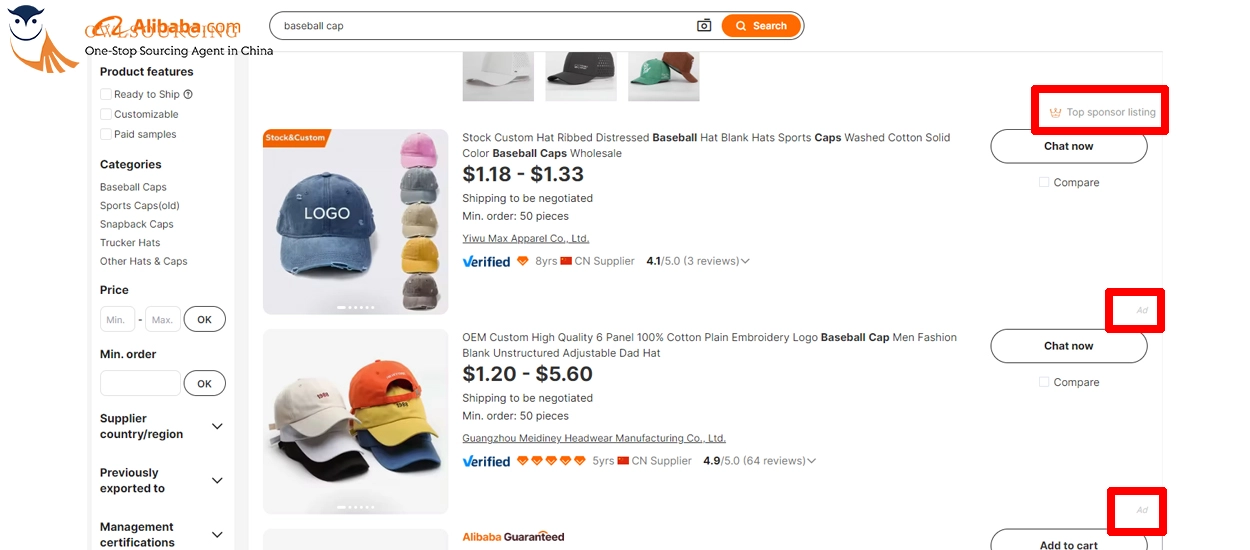
You need to know why these suppliers show up on the search results page and understand the listing rules on Alibaba.
Here is the result when you search the keyword “baseball cap”:
What do you see? You can see “sponsored listing” on the product links, which means the suppliers have paid Alibaba for an excellent position on the results page to increase their traffic on the website.
Sponsored listings mostly show up on the first eight results on the first page.
If a baseball cap seller doesn’t want to pay for priority product ranking, then the product may only be shown after ten more result pages.
Why does the Alibaba listing policy work that way? For sure, one of the reasons is that the website needs to be profitable.
Now, the buyers on Alibaba can leave reviews and see the supplier’s transaction records for the past six months in the supplier’s company profile.
The Alibaba team is trying to incorporate more B2C elements into the traditional B2B website.
The products you may see on the first results page are usually there because they paid for that, or the company is good at e-commerce marketing.
On the other hand, the vendor will probably pass these costs onto you if they paid Alibaba for the high ranking.
Once you understand the Alibaba listing policy, you can work more effectively when approaching suppliers. Some suitable suppliers are not listed on Alibaba.
Tip 3: Look at the supplier’s profile and the Alibaba reviews
Check out the supplier’s company profile before you approach the supplier, as you can access reports from buyers from all over the world.
Pay more attention to negative feedback because that might happen to your business, as well.
By reviewing the company profile, you will learn what specific category this vendor is in and if they are a factory or a trading company.
Defining the vendor through this useful information will give you an idea about how to work with the supplier.
Tip 4: Make sure you know the type of companies that are listing products on Alibaba

You may have already realised that you will probably get the best price by purchasing from the factory directly. Is that correct?
Yes and no. Both the manufacturer and the trading company or China sourcing agent have advantages and disadvantages.
Evaluate your business and sourcing skills before making decisions about the type of partners you want to have.
If you are a professional buyer or have an office in China already, then you could work with the factory directly because you have enough skills to handle different situations.
If you are a newbie ready to start your journey sourcing in China, then working with sourcing agents might be a good option because they will help you monitor the performance of the manufacturer through their workflow.
The ultimate target is still to find a low-priced and decent-quality product that can ship to your warehouse on time, so do not over-focus on the cost alone.
Cost is undoubtedly one of the key points to consider, but you need to view all the factors within the order process.
One of the excellent features of a professional supplier is that they want to work with you and are willing to make your business successful rather than make money from you.
More importantly, they work proactively, so you don’t need to push them to deliver a good result.
Challenges to Consider when Sourcing from Alibaba
- Quality risks: Packaged products may not always meet the standard as portrayed in advertisements.
- Scams: Risk of having dealings with unscrupulous suppliers or fake products (Be familiar with the latest trends in Alibaba scams).
- Middlemen: It means that some of the suppliers are actually trading companies and not manufacturers.
- MOQ constraints: They used to offer big discounts or combine some products together when ordering in larger quantities.
Six Common Misconceptions when Buying from Alibaba
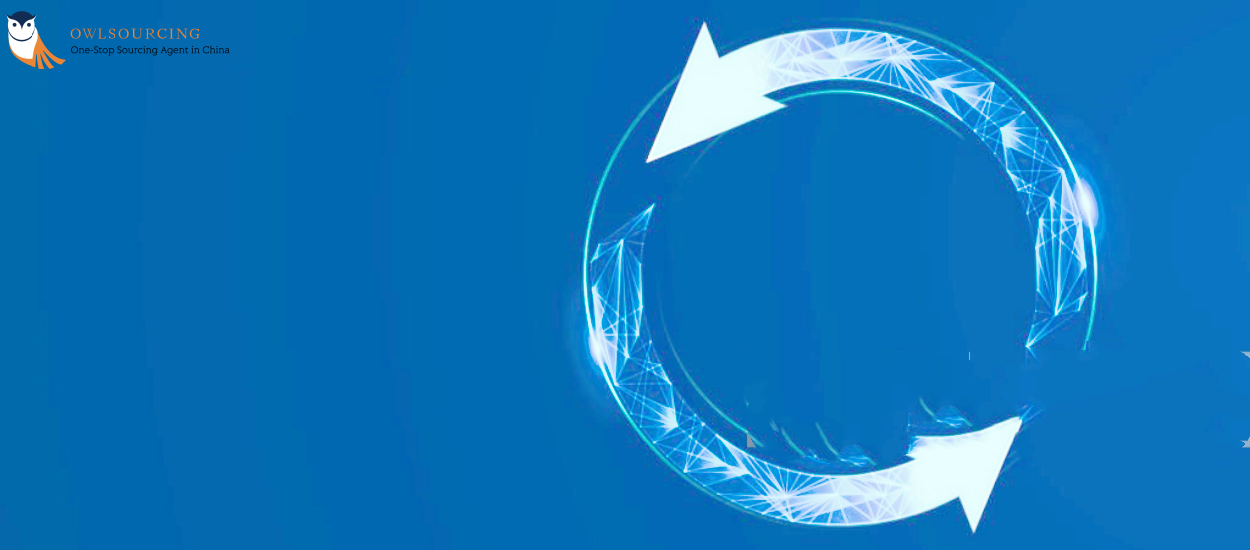
1. Different ideologies (Buyer and Seller)
You may think that the supplier should follow the same doctrines as you, but they may be different because you are from diverse backgrounds
2. All the China Wholesale Vendors are the same
Do you think that all sourcing agents, trading companies, and manufacturers are the same? In reality, they are all different, and you should know how they work.
A factory is the place of origin for your products. The factory might produce and pack the final products and then ship them to your warehouse or the Amazon FBA warehouse.
The trading company will collect or organise different samples to create a product line and show buyers how to get the PO. They have an existing relationship with various vendors.
A sourcing agent can customise your request and provide various services. It will also share the name of the manufacturer with you if you want.
A sourcing agent can help you with factory audits, product sourcing, order follow-ups, inspections, and managing the entire order process.
They are helpful if you want to run your own private label business, especially on Amazon.
3. Assume sea shipping is always the cheapest option
Is sea shipping the best way to ship your goods to their destination? It can be if you can use full-container shipping (FCL), which is when your cargo fills an entire shipping container.
For example, a full-size 1′ x 20′ GP container is around 26 m³, so sea shipping would be a good option if the total cubic meter of your cargo is close to 26m³.
Then, the total cost will be much lower than that of air freight or air couriers (e.g., DHL, FedEx, UPS).
You most likely won’t meet the load requirements for full-container shipping. Then what do you do? You will need to compare the different shipping methods and costs.
Airfreight
This procedure is similar to sea shipping. You will need to contact a shipping forwarder and arrange delivery of the cargo to the appointed forwarder’s warehouse in China.
The shipping forwarder will arrange the shipping by plane to the destination, and it will help you to declare the load at customs and do the standard import process.
The most important thing is that you need to hire a forwarder you trust and ask for the price in advance. Then you will have an idea of how much it will cost.
We suggest using air freight when the cargo is above 500 kg, and the price is competitive with that of air couriers such as DHL, FedEx, and UPS.
Air Couriers
Several air carriers are famous for their convenient and fast service. They also help simplify the customs declaration process, especially when the total value of the shipment is under $800, and you don’t need to pay import taxes!
You can always ask air couriers for the door-to-door cost for the shipment and compare it to find the best option for a small purchase. See the price chart below for reference.
In a future post, we will talk about how to choose the shipping method correctly.
4. Think All the Best Chinese wholesalers are listed on Alibaba
Importers, especially the new ones, usually assume that all Chinese manufacturers/suppliers are on Alibaba. Is that correct? Oh, no!
Many top suppliers are not even interested in listing themselves on this website because they are too busy and want to focus on their business.
These manufacturers usually work with a trading company, and they don’t have a team to service foreign importers, and they don’t want to do that.
Why? Directly servicing overseas customers means that these factories must establish an English-speaking crew, which increases the possibility of problems.
They would instead focus on the products and work with local trading companies or sourcing agencies instead of extending their business focus.
5. Overtrust a high-ranking supplier on Alibaba
You have already learned that high-ranking listings on Alibaba are the result of paying ad fees to Alibaba.
As you can imagine, these companies derive more value by listing their products in the best position on the website, and they gain a lot of traffic by continuing to do that.
We suggest not over-trusting the reviews or transactions shown on such suppliers’ Alibaba pages; that’s just a consequence of using the paid service and does not mean that the supplier is indeed a high-level supplier.
Read more about the “Reality of Alibaba Verified Suppliers“.
6. Skip the Sample Confirmation Process
Please never ignore the sample check before issuing the PO to the supplier. You may start working on a single product, such as a new design ballpoint pen project.
It looks like a simple project, but sometimes it turns out to be more complicated than you expected.
Why? Because you assumed it was a pure product, and you didn’t review samples!
Reviewing samples is a critical step. You need to check, especially the master production sample, before giving a direct order to the factory to start production.
It’s essential to check and confirm the sample product and inform the supplier of any defective points before mass production.
How to Source and Negotiate with Suppliers on Alibaba?
Step 1: Register an account on Alibaba
First, register on Alibaba so that you can directly communicate with vendors and ask for more detailed information about the product.

Verify your email and fill in your personal or company information to register for free.

Step 2: Analyse and collect more information about your product
You already know that you need to gather as much information as you can about the product you are going to sell, such as material, dimensions, packing, quantities, and so on. Then, you can approach suppliers.
The China wholesalers expect that you know what products you are looking for, and then they can submit their offers. The suppliers will evaluate your business and see if they want to provide a quote.
Think about it: if you were a supplier and there was a buyer who contacted you who was not so clear about the product he wanted, then how likely is it that he would place an order with you?
Provide suppliers with a detailed “request for a quote” (RFQ) with specific information about the product you want. Doing so will let them know that you are a real buyer and that you intend to place a purchase order.
China’s business environment is all about relationships, so try your best to establish a good relationship with the supplier.
Suppliers receive many inquiries every day, and they must optimise their service targets and work with only the most valuable clients.
Step 3: Narrow down the suppliers and send an inquiry to the top supplier for a complete quote.
We have learned more about our product, and it looks like we’ve found the ideal product with detailed product information already:

Now we can send an RFQ to several potential professional suppliers on Alibaba and await their quotes. Here is an example of an inquiry for reference:
Hi Sally,
My name is Mike, and I’m a buyer looking for a baseball hat to sell on my website. I am interested in your product, especially the “Daddy” hat.
Please send your complete quote and pricing for 500–1,000 units. Please also share all the information about the product, such as the MOQ, product dimension, material, packing information, and lead time— it will be helpful when we calculate the landing cost to our warehouse.
Thanks!
Step 4: Check the details of the quotes from the different suppliers
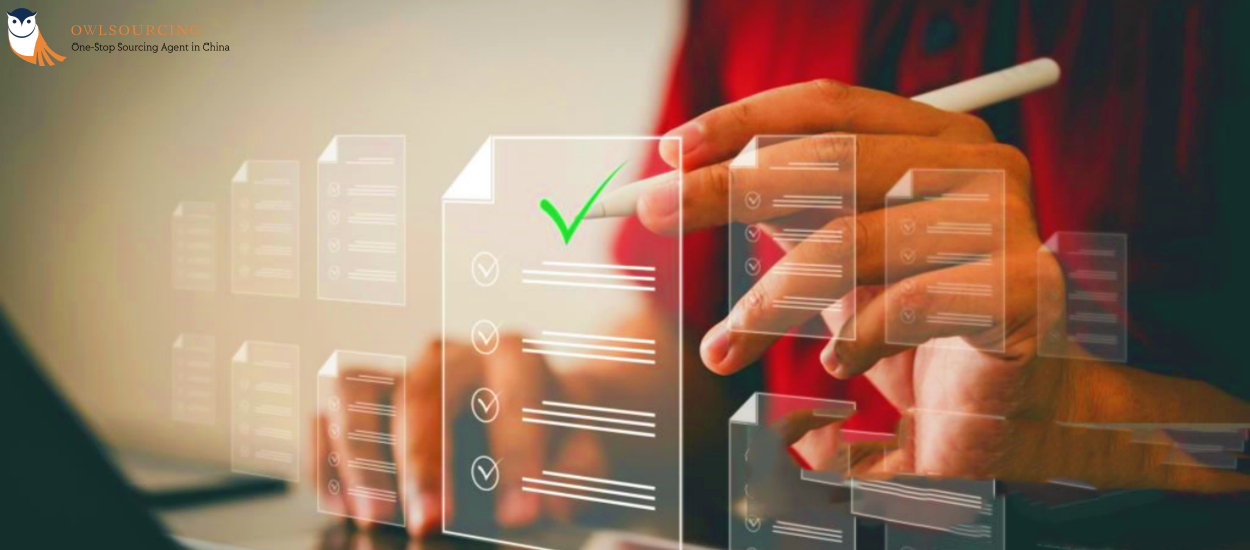
Usually, you would need a “quote follow-up” because you would find the vendors might neglect the information, which is essential to you, such as the packing info, material, H.S. Code, lead time, payment terms, etc.
That information is necessary when you intend to fulfil an order.
Here is a list of the necessary information that should be included within a complete quote:
- Item number.
- Image.
- Description (material, colour, dimensions).
- Packaging information. The packing method should be based on your request or be the supplier’s standard offer.
- Unit price in USD. Be aware of whether the supplier quotes a fee on board (FOB) price or ex-works (EXW) price because these two prices are different.
- Import duties. Check the import duties with the supplier and verify them later by yourself. Here is an official USA Harmonised Tariff Schedule website for you to check the import duties and the product’s HTS Code when imported from China to the U.S: https://hts.usitc.gov/

- HTS code. The code index in the Customs categorises one specific product with its corresponding import duty. The supplier can provide it, but you need to verify it later by yourself, as the information might be slightly different.
- International freight costs. Check with your shipping agent or let the supplier quote a price if it’s a small shipment that can be shipped by air couriers such as DHL, FedEx, or UPS.
- Packing information. Pieces per carton, carton dimension, and master carton weight. This information will help you understand the total cubic meters and carton weight, which will affect the international logistics fees.
For example, let’s say that you ordered 1,000 “Daddy” caps. The supplier packs 100 units per carton.
Each carton is 50 cm x 40 cm x 40cm, the gross weight per box is 9 kg, and the net weight per box is 8 kg. Therefore, the total packing information for this shipment would be as follows:
Number of Cartons: 10 cartons
Full Cubic Meters: 0.8m3
Gross/ Net Weight: 90/80 kg

- Minimum Order Quantity of the order. There was a minimum order quantity request when you customised your private-label products. In some cases, the Chinese factories will have the stocks, but usually, they only produce according to the orders they receive. It always happens that the MOQ is set up at a high number, so you need to negotiate with the supplier if it seems totally out of your range.
- Lead time. The supplier will provide lead time based on the quantity you are going to buy or the MOQ. The lead time gives you an idea of how long production will take, so you can estimate when the cargo will reach its destination.
- Payment terms. Check the payment terms requested by the supplier. You can always discuss them if you intend to issue a large order.
- Sample costs. Ask for sample costs and remember to always check the sample before placing the official PO. You need to review a mockup sample, not the initial sample.
- Logo printing costs. Ask the supplier to quote a price based on the specific logo you need to print as a private label on your product.
Use all the above information to analyse the quotes from each supplier and then move to the next step: Check the Sample and negotiate the price.
Step 5: Negotiate the price with the Chinese wholesale vendors
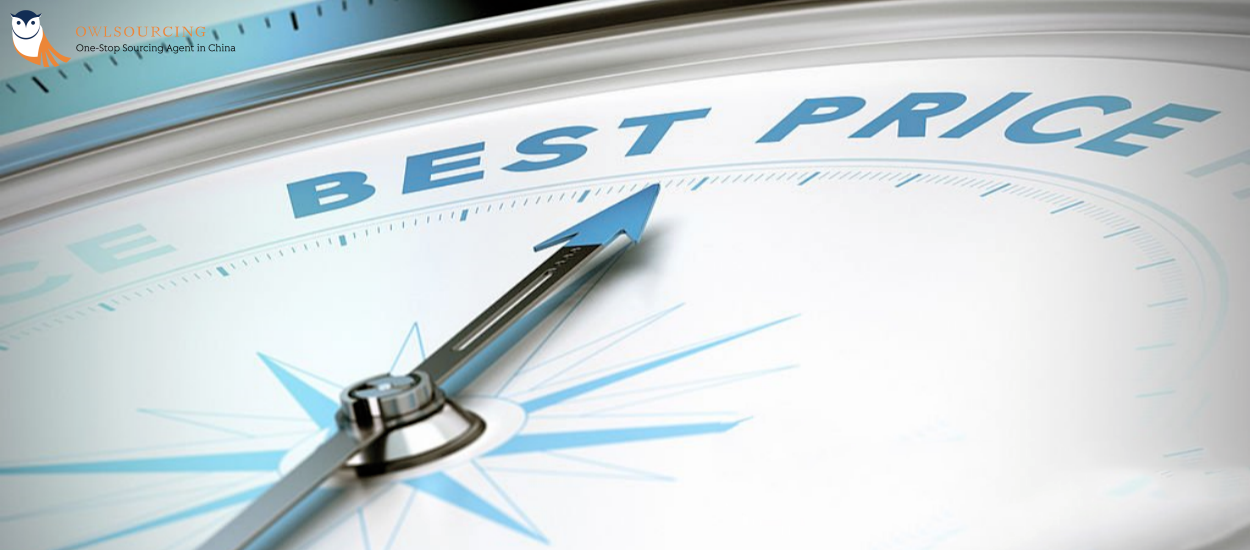
Once you have targeted a potential supplier to work with, and are happy with the sample that is provided. It’s time to negotiate the price and specific terms included in the contract.
The negotiations always depend on your order quantity. If your order size is small, then you will probably have minimal negotiation power. Set up your target price after you analyse the retail price and other costs like logistics and tariffs.
You can also negotiate the sample cost if it is incredibly high. The sample order is necessary before moving to the next step.
Don’t be afraid that negotiating will affect your business relationship or your reputation.
Negotiating is a business, and you have the right to discuss each term before making the official purchase order. You won’t be the first to ask, nor the last to negotiate contract terms.
Sourcing and Buying from Alibaba: Pros and Cons
Pros:
1. Low Cost
You can directly communicate with the supplier and get a low cost by connecting with them on Alibaba.
2. Easy to Analyse
The abundant resources and simple category structure on Alibaba make it easy to analyze high-potential products
3. Saves Time and Money
You can find everything on this website due to the wide variety of products available. It will save you time and money compared to participating in a trade show such as the Canton Fair.
Cons:
1. Biased Product Listing Policy
Alibaba’s listing policy has made it difficult for other suppliers to show up. Therefore, buyers end up paying more by working with suppliers who pay extra to Alibaba. Always remember that suppliers will pass the cost to their buyers.
2. Suppliers’ Poor Order Management Skills
You can hardly identify whether a supplier is professional enough to manage your order. It might happen due to poor communication, the language barrier, or meeting a supplier who is not professional enough.
3. Lack of Responsibility
Even with assurances on the Alibaba website, it’s hard to define who is responsible when an issue occurs. Alibaba might not be able to judge the trade issue during the ordering process.
Tips for Safe Buying from Alibaba
Safe buying from Alibaba is important. Consider the following tips for safely sourcing from Alibaba:
- Verify suppliers: Check for the verified supplier program of Alibaba, and must go through the reviews.
- Request samples: Quality check is important when you are planning on ordering large quantities of commoditised products.
- Secure payments: To make payments as safe as possible, it is recommended to use Alipay and Trade Assurance services.
- Avoid branded goods: Products that bear a brand name should not be sold without a license, since it is unlawful.
The Role of China Sourcing Agents
Benefits of a sourcing agent include supplier authentication, price negotiation, sample estimation, and quality assurance.
Since agents have direct exposure to these markets, have the necessary language proficiency, and are based in the country, they can ease the effort, especially for first-time buyers.
Owlsourcing is your outsourced purchasing agent and partner in China, assisting with product sourcing and manufacturing.
We work with local factories to provide comprehensive support for production, including supplier verification, price negotiation, quality assurance, and delivery.
Read More:
- Alibaba Alternatives: 12 Sites Like Alibaba to Source
- How to Make a Prototype in China?
- Importing Children’s Products from China
- What is Fulfilment by Amazon (FBA)?
Final Thoughts
You need to start your journey with the online wholesale market and go through the process by yourself. Only then will you find the best ways to derive value in the resource market.
Don’t be frustrated with the hassles of importing from China. Your ultimate target is to get a cheap, high-quality product from China that can make you a good profit.

